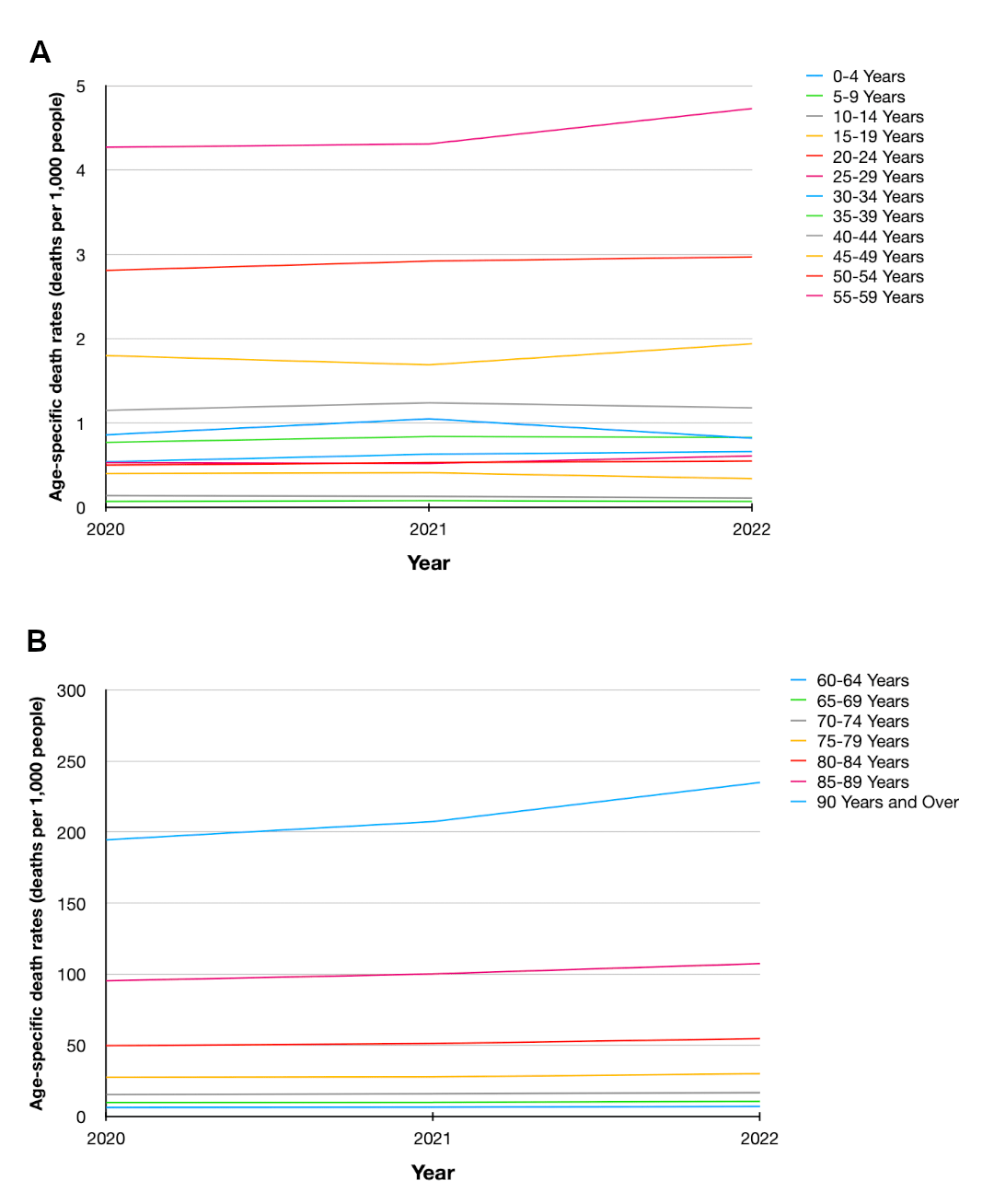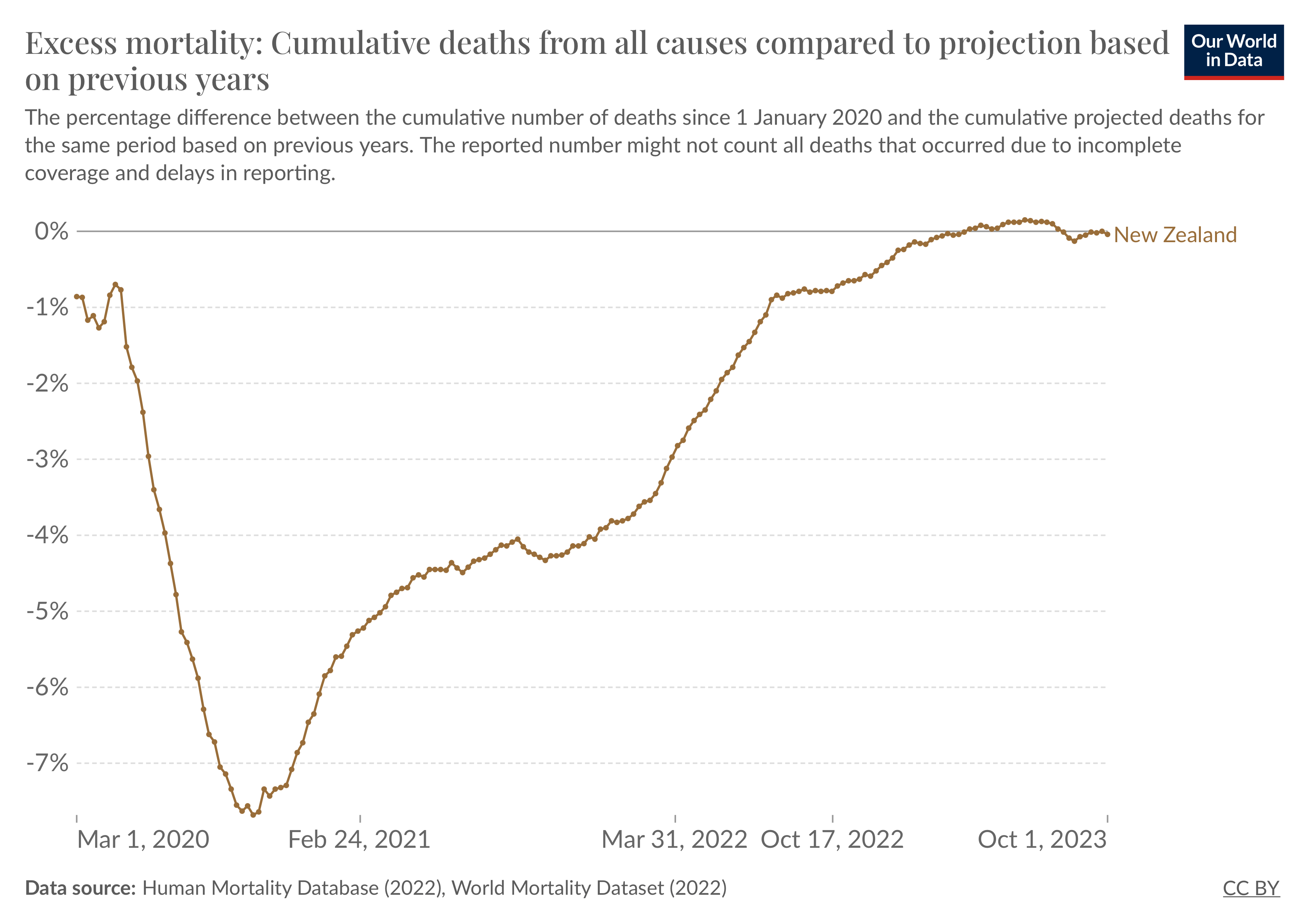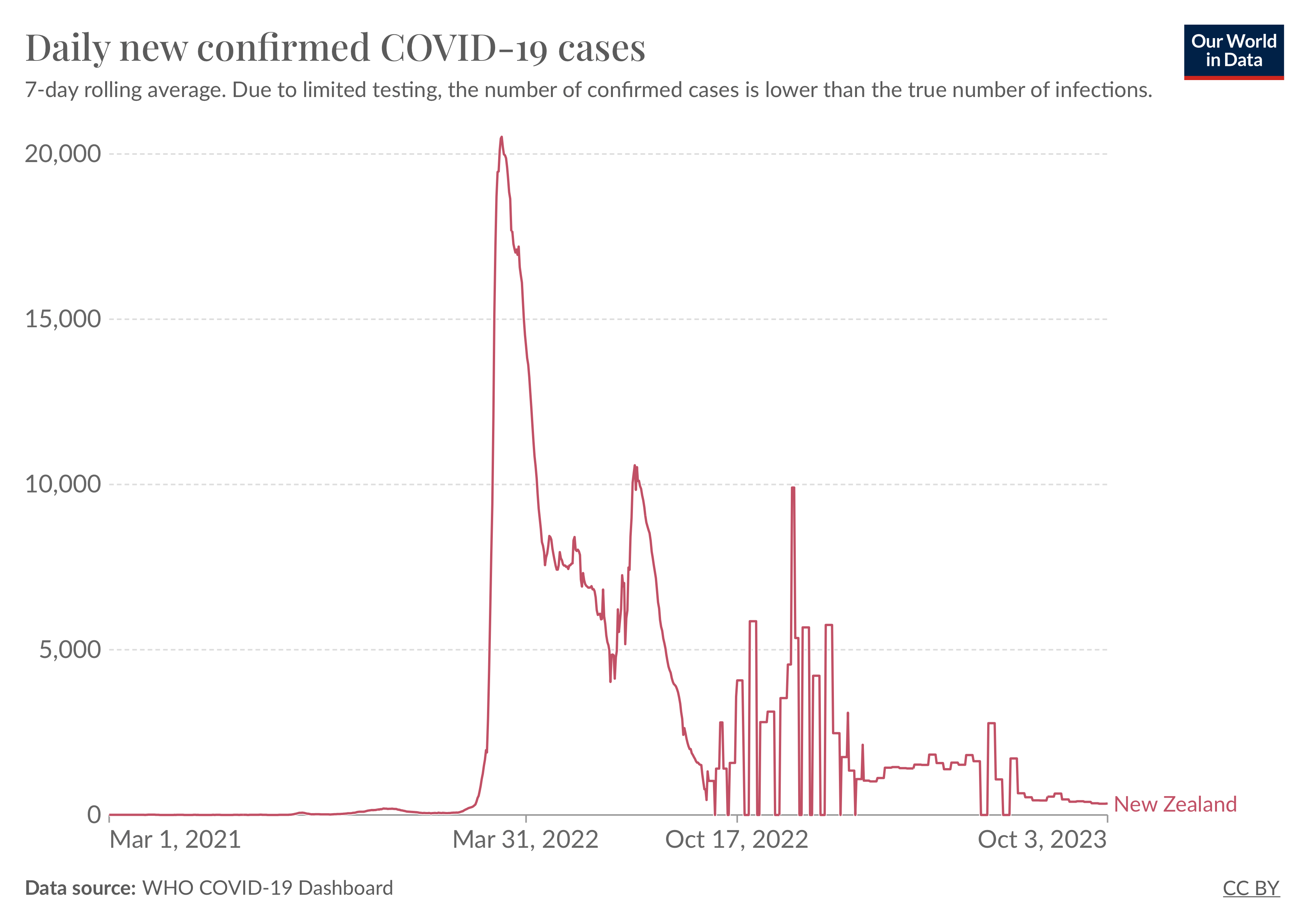

FULL CLAIM: “Data from the New Zealand Ministry of Health shows that the COVID vaccines have killed over 10 million worldwide”; “the COVID vaccines have killed millions of people worldwide, an estimated 1 death per 1,000 doses on average in a standard population”
REVIEW
On 30 November 2023, entrepreneur Steve Kirsch gave a talk at the Massachusetts Institute of Technology, claiming that New Zealand data showed COVID-19 vaccines have “killed over 10 million worldwide”. Kirsch, who had been invited to speak by the student group MIT Students for Open Inquiry, has a record of propagating vaccine misinformation. As documented in previous reviews by Health Feedback, Kirsch’s claims frequently rely on methodologically flawed analyses.
The video recording of Kirsch’s talk has been archived here and the slides he presented during the talk can be found here. The Rumble video of the talk has been viewed more than 217,000 times.
The New Zealand data used by Kirsch turned out to be personal health information taken from government databases without authorization by Barry Young, a database administrator who worked for Te Whatu Ora, New Zealand’s public health agency.
The New Zealand Herald reported that Young was arrested on 3 December 2023 in connection with the privacy breach and has been charged with “accessing a computer system for dishonest purposes”. Prior to his arrest, Young had appeared in a video with Liz Gunn, a former TV presenter and anti-vaccine campaigner, which revealed that he had taken the data from the database. He had appeared under the pseudonym “Winston Smith” (the name of the protagonist in George Orwell’s novel “Nineteen Eighty-Four”).
Kirsch uploaded the illegally acquired data online and signaled to his Substack readers that they could download the data for themselves, although he also claimed to have anonymized the data. Te Whatu Ora has since been granted an injunction to prevent any publication of the data to protect the privacy of those affected by the breach. Kirsch and other individuals have had their accounts on private hosting services taken down after using these services to host the data.
In this review, we examine the claims made by Kirsch and explain why the claims cannot be substantiated by the New Zealand data that he obtained. We will also present the evidence showing that, contrary to the claim, COVID-19 vaccination isn’t responsible for “millions of deaths worldwide”.
How the analysis was performed
According to a Substack post published by Kirsch on 1 December 2023, the New Zealand data he used consisted of health records linked to four million doses of COVID-19 vaccine, out of the 12 million administered in the country so far.
The data came from the pay-per-dose program and included information such as the type of vaccine the person received, as well as their date of birth and death, if death occurred.
Kirsch’s analysis used what he called a “time-cohort series analysis”, which he considered the “gold standard”, a claim that wasn’t substantiated with evidence. To do this, he plotted the number of deaths that occurred in the months after COVID-19 vaccination.
He concluded that COVID-19 vaccines were responsible for millions of deaths based on the fact that his analysis showed deaths rose in the first six months after vaccination in those aged 60 and above. The same trend was also seen in an overall analysis for all ages (shown in slides 136 to 140).
If the COVID-19 vaccines were safe, he argued, then mortality in vaccinated people should have fallen or remain unchanged, with the exception of the first three weeks post-vaccination. According to Kirsch, a rise in mortality in the first three weeks post-vaccination could be explained by the healthy vaccinee effect (asserted in slide 13), but not for any later rise in mortality. For Kirsch, a later increase in deaths could only be due to vaccines.
The healthy vaccinee effect can come about because vulnerable people who are more likely to get vaccinated are also more likely to die compared to the general population. But Kirsch provided no reliable evidence to support the assumption that this effect can only last for three weeks or that only COVID-19 vaccines can explain later deaths.
He previously applied the same method to U.S. Medicare data to claim “COVID vaccines increase your risk of dying”, which Health Feedback analyzed back in March 2023. This Medicare analysis also appeared during his talk at MIT. In our earlier review, we found that Kirsch’s Medicare data analysis didn’t account for the effects of seasonality and COVID-19 waves. As such, his analysis incorrectly attributed deaths from COVID-19 and seasonal illnesses to COVID-19 vaccines.
The caveats and limitations of Kirsch’s analysis
There are more important caveats and weaknesses associated with Kirsch’s analysis.
Firstly, we don’t know if the data he used represents a random selection of the general population. In his Substack post, Kirsch asserted that whether someone is in the pay-per-dose program is “pretty random”, but this is an assumption that Kirsch didn’t test or demonstrate to be true.
Secondly, by Kirsch’s own admission, the data wasn’t complete. On Substack, he wrote that “Many people will not have all their doses in this database, e.g., there may just be dose 3 data for someone”. This means we don’t have a full picture of vaccination outcomes for every individual with records in the pay-per-dose data, which makes it even more difficult to calculate an accurate mortality rate in this population.
David Gorski, a surgical oncologist and editor at Science-Based Medicine, who discussed Kirsch’s analysis at length in this article, countered that:
“[I]f you are going to assert that, for purposes of your analysis, incomplete records and uneven sampling in the dataset don’t matter, you really do need to show the receipts and mathematically prove that these deficiencies in the dataset don’t affect the results of your analysis.”
In particular, he highlighted how epidemiologists would test their data using multiple approaches in order to determine if the assumptions used in their analyses are sound (also called sensitivity analysis).
Thirdly, the data contained no information on mortality in unvaccinated people. Kirsch also didn’t compare mortality rate with that of the pre-pandemic baseline. Without this information, it’s impossible to establish whether the mortality rate in vaccinated people is actually different from that of unvaccinated people.
Fourthly, Kirsch’s analysis emphasized deaths in the elderly, glossing over some important mortality trends in New Zealand over the past three years, which we discuss in the next section.
Rise in mortality in older age groups is most likely due to a return to baseline mortality, not excess mortality caused by vaccines
Jeffrey Morris, biostatistician and professor at the University of Pennsylvania, was among the experts who analyzed Kirsch’s claims.
On X/Twitter, he pointed out that the rise in mortality Kirsch observed in the months after vaccination was only present in senior citizens, but not in children or younger adults. However, Kirsch’s choice to show only deaths in those aged 60 and above and the all-ages mortality—with the latter primarily representing deaths in the elderly—obscured this fact.
This left one with the impression that this rise in mortality occurred across the entire population, when this only affected the elderly.
New Zealand’s official data agency, Stats NZ, reported in February 2023 that:
“Deaths are gradually increasing over time, despite a generally increasing life expectancy. This is because of population growth, and more people in older ages where most deaths occur. Four out of every five deaths in 2022 were to people aged 65 years and older, and just over half (53 percent) were to those 80 years and older. The number of people in the population reaching these older ages is increasing, which will therefore increase the number of deaths occurring”.
Health Feedback also obtained population mortality data from Stats NZ’s Infoshare website, which provides this data stratified by age (see Figure 1 below). The data show that in groups below the age of 60, there was no substantial change in mortality rate between 2020 and 2022. This is sufficient to refute the implication that COVID-19 vaccines have caused widespread deaths across New Zealand’s entire population.

Figure 1 – Age-specific mortality rates for groups aged 59 and below (A) and groups aged 60 and above (B). Note that the mortality rates for those below 60 are substantially lower than those aged 60 and above; the maximum value for the y-axis (that is needed to display data fully) in A is five, but 300 in B. Additionally, the y-axis interval in A is one, but 50 in B. Mortality rates in A show no significant increase between 2020 and 2022, but increases can be seen in B, particularly for those 80 years old and above. Source: Stats NZ Infoshare.
The next question is why mortality in elderly groups has risen and whether this could be plausibly attributed to COVID-19 vaccines.
To answer this question, we need to account for the fact that New Zealand actually experienced negative excess mortality in the first two years of the pandemic (see Figure 2 below), meaning that there were fewer deaths compared to the historical baseline, unlike most other countries during the pandemic. This has been attributed to New Zealand’s strict elimination policy, enacted in 2020 and 2021.

Figure 2 – Excess mortality in New Zealand from March 2020 to October 2023. Note the large negative excess mortality spanning from March 2020 to around early 2023. Source: Our World in Data.
In October 2021, New Zealand switched to a mitigation policy and relaxed restrictions. This was followed by the introduction of the Omicron variant into the country, which led to a wave of infections in early 2022 (see Figure 3 below). By comparing Figures 2 and 3, we can see that the rise in mortality in New Zealand corresponds to the wave of COVID-19.

Figure 3 – Confirmed new COVID-19 cases in New Zealand from March 2021 to October 2023. Note the spike in COVID-19 cases beginning around March 2022. Source: Our World in Data.
A letter to The Lancet, in which scientists from the Medical Research Institute of New Zealand analyzed weekly all-cause mortality in 2020, 2021, and 2022[1].
They found that:
“In 2020, there was a negative excess mortality with 439.4 fewer deaths per million, potentially due to several factors including the elimination of COVID-19, markedly reduced burden of influenza and other respiratory viruses, and fewer deaths from road traffic accidents, occupational causes, air pollution, and post-surgical complications.”
2021 also saw negative excess mortality, with less than a quarter of the population diagnosed with COVID-19, and “weekly mortality rates fluctuated around the historical mean with a negative excess mortality of 7·6 fewer deaths per million population”.
By early 2022, 93% of the eligible population in New Zealand had already been fully vaccinated. However, a relaxing of restrictions came hand in hand with the spread of Omicron, leading to “excess mortality of 662.4 deaths per million population, predominantly due to COVID-19-attributable deaths.”
When all of these data and findings are taken together, it suggests that the huge negative excess mortality was due to COVID-19 restrictions, which have since been lifted. And with the lifting of restrictions, deaths due to causes like flu and other respiratory viruses, as well as other causes like car accidents, have made their return.
Therefore, the later rise in mortality in the elderly that Kirsch observed very likely represents a return to baseline mortality, rather than excess mortality caused by the vaccines, Morris pointed out in an exchange with Gorski.
In a separate thread on X/Twitter, Morris emphasized the importance of considering multiple potential explanations for a certain observation, due to confounding factors and bias inherent to observational data:
“As I would emphasize, any genuine attempt to assess potential causal effects of vaccines requires consideration of controls and adjust for confounding and other sources of bias inherent to these observational data in the pandemic (as may published studies do), but it might be useful for some to consider looking at these data as a basic plausibility filter for assessing whether they think the excess deaths are primarily driven by vaccination or by covid.”
Published studies in the U.S. and Hungary haven’t found COVID-19 vaccination to be associated with a greater risk in mortality[2-4].
The observation that there was negative excess mortality in 2021, coupled with the fact that more than 90% of those eligible for the vaccine had already received at least one dose in 2021, means that Kirsch’s claim simply doesn’t hold up under scrutiny. If COVID-19 vaccines were as deadly as Kirsch claimed, with a mortality rate of one in a thousand vaccinated people, then we would have seen this manifest as excess mortality in 2021.
A similar claim related to the New Zealand dataset, made by the X/Twitter account Leading Report which we investigated, is that it showed 20% of New Zealanders died from the COVID-19 vaccines. USA Today covered this claim in a fact-check, speaking to experts who explained the math simply didn’t add up:
“Nearly 4 million people in New Zealand have received two doses of an mRNA COVID-19 vaccine as of Dec. 1, according to public health agency Te Whatu Ora. For the claim to be true, at least 800,000 of those vaccinated people would have had to have died. But from the start of 2020 through June 2023, there were about 125,000 total deaths attributed to all causes, according to Statistics New Zealand, the country’s government data agency.”
Kirsch told USA Today that he stood by his analysis.
Conclusion
Kirsch’s analysis of a subset of New Zealand vaccination data is methodologically flawed and makes unjustified assumptions about the data, such as by claiming the data represent a random sample, when no evidence was provided to show this was the case. It also cherry-picked the data it presented, implying that the rise in mortality seen in the elderly also applied to other age groups.
In fact, this rise was limited to the elderly; no significant changes in mortality in children and younger adults occurred in New Zealand between 2020 and 2022.
New Zealand’s strict elimination policy during the first two years of the COVID-19 pandemic produced a huge negative excess mortality, as it didn’t only minimize COVID-19 deaths, but also reduced deaths from causes like respiratory illnesses, traffic accidents, and surgical complications.
This policy later shifted to a more relaxed mitigation policy. This also meant that the causes of death diminished by COVID-19 restrictions made a comeback, in tandem with a rise in mortality rate in the elderly. While this rise is genuine, it doesn’t represent excess mortality from vaccines as some have claimed, but a return to baseline mortality.
Correction (11 December 2023):
The review initially wrote that the name of the individual charged with accessing the New Zealand database for dishonest purposes was Barry White. This is incorrect. It should be Barry Young. We have corrected this error.
REFERENCES
- 1 – Kung et al. (2023) New Zealand’s COVID-19 elimination strategy and mortality patterns. The Lancet.
- 2 – Pálinkás and Sándor (2022) Effectiveness of COVID-19 Vaccination in Preventing All-Cause Mortality among Adults during the Third Wave of the Epidemic in Hungary: Nationwide Retrospective Cohort Study. Vaccines.
- 3 – Xu et al. (2021) COVID-19 Vaccination and Non–COVID-19 Mortality Risk — Seven Integrated Health Care Organizations, United States, December 14, 2020–July 31, 2021. Morbidity and Mortality Weekly Report.
- 4 – Tu et al. (2023) SARS-CoV-2 Infection, Hospitalization, and Death in Vaccinated and Infected Individuals by Age Groups in Indiana, 2021‒2022. American Journal of Public Health.


